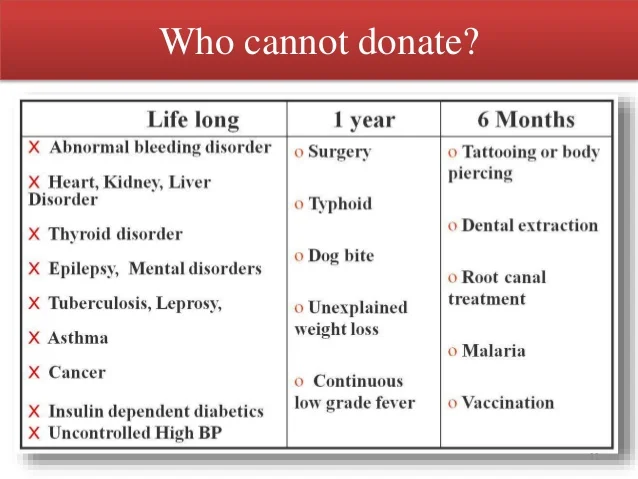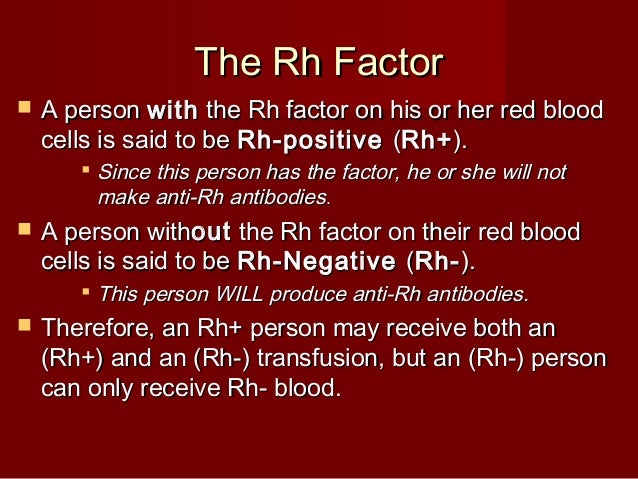| Recipient Blood Type | Matching Donor Blood Type |
|---|---|
| B+ | B+, B-, O+, O- |
| B- | B-, O- |
| AB+ | Compatible with all blood types |
| AB- | AB-, A-, B-, O- |
What conditions disqualify you from donating blood?
9 rows · Donors with type O- blood are universal red cell donors whose donations can be given to people of all blood types. Donors with types AB- and AB+ blood are universal plasma donors, while patients with type AB+ are universal red cell recipients because they can receive red cells from all types. All other donors and recipients must be safely matched, for example:
What are the 8 different blood types?
Is one of the most common and, consequently, most transfused blood types — 35.7% of the US population has type A+ Can give blood products to types A+ and AB+ and receive all A and O types Is an ideal whole blood, double red blood cell or apheresis platelet donor Donation type is based on…. Read More.
What are the 3 rarest blood types?
Donors with blood type B... can donate to recipients with blood types B and AB Donors with blood type AB... can donate to recipients with blood type AB only Donors with blood type O... can donate to recipients with blood types A, B, AB and O (O is the universal donor: donors with O blood are compatible with any other blood type)
What blood type can take any blood?

Can O positive donate blood to O negative?
Type O positive blood is critical in trauma care. Those with O positive blood can only receive transfusions from O positive or O negative blood types.
Which blood types can donate to each other?
Donors with blood type O... can donate to recipients with blood types A, B, AB and O (O is the universal donor: donors with O blood are compatible with any other blood type)
What blood types can the 4 blood types donate to?
What are the major blood types?If your blood type is:You can give to:You can receive from:A PositiveA+, AB+A+, A-, O+, O-B PositiveB+, AB+B+, B-, O+, O-AB PositiveAB+ OnlyAll Blood TypesO NegativeAll Blood TypesO-4 more rows
Is O+ or O universal donor?
Although the blood type O+ can donate blood to all positive blood types (A+, B+, AB+, and O+), it is not a universal donor. Blood type O- is the universal blood donor, meaning that people with this blood type can donate blood to all other types with a lower risk of causing serious reactions.Jan 20, 2022
What are the 3 rarest blood types?
What are the rarest blood types?O positive: 35%O negative: 13%A positive: 30%A negative: 8%B positive: 8%B negative: 2%AB positive: 2%AB negative: 1%
What's the rarest blood type?
type ABIn the U.S., the blood type AB, Rh negative is considered the rarest, while O positive is most common.May 18, 2020
Do they tell you your blood type when you donate blood?
Donors may be notified of their blood type following their donation when they receive their blood donor card or by creating a profile through the Red Cross Blood Donor App. You must be in good health. Seasonal illnesses like the flu can affect a blood donor's ability to give.Nov 6, 2019
Can B negative donate blood to B positive?
Around 1 in 8 people can receive red blood cells from B negative donors. B negative blood can help people who are: B negative. B positive.
What type of blood can b positive receive?
B positive red blood cells can be given to both B positive and AB positive patients. B positive patients can receive blood from B positive, B negative, O positive and O negative donors.
Why O positive is not universal donor?
O positive blood can't be used universally because it has the Rh factor, but it is compatible with all positive blood types including O+, A+, B+, and AB+. Since over 80% of the population has a positive blood type, type O positive blood is in high demand.Jan 8, 2021
Is O positive a rare blood type?
O positive is the most common blood type as around 35% of our blood donors have it. The second most common blood type is A positive (30%), while AB negative (1%) is the rarest.
Can O Positive be universal donor?
Although O+ is considered to be a universal donor, O- is the actual universal donor because A, B, and Rh antigens are absent in the latter. So, it can be given to anyone, irrespective of the blood group.Feb 8, 2021
What blood type is used for transfusion?
O negative blood can be used in transfusions for any blood type. Type O is routinely in short supply and in high demand by hospitals – both because it is the most common blood type and because type O negative blood is the universal blood type needed for emergency transfusions and for immune deficient infants.
What are the 8 blood types?
In addition to the A and B antigens, there is a protein called the Rh factor, which can be either present (+) or absent (–), creating the 8 most common blood types ( A+, A- , B+, B- , O+, O- , AB+ , AB- ). Click on a blood type below to learn more.
How are blood types determined?
Blood types are determined by the presence or absence of certain antigens – substances that can trigger an immune response if they are foreign to the body . Since some antigens can trigger a patient's immune system to attack the transfused blood, safe blood transfusions depend on careful blood typing and cross-matching.
How many lives are saved by blood transfusions?
Each year 4.5 million lives are saved by blood transfusions. There are very specific ways in which blood types must be matched for a safe transfusion. The right blood transfusion can mean the difference between life and death. Every 2 seconds someone in the US needs a blood transfusion.
Is blood type inherited?
It’s inherited. Like eye color, blood type is passed genetically from your parents. Whether your blood group is type A, B, AB or O is based on the blood types of your mother and father. Click on a blood type below to see how it is. passed on genetically. O.
Is O negative blood high?
Types O negative and O positive are in high demand. Only 7% of the population are O negative. However, the need for O negative blood is the highest because it is used most often during emergencies. The need for O+ is high because it is the most frequently occurring blood type (37% of the population).
What percentage of the population has O blood?
Is one of the rarest blood types — only 6.6% of the US population has type O- Is a universal donor, meaning anyone can receive type O- blood products Is an ideal whole blood or double red blood cell donor. Your blood type is constantly needed, so please come in and donate as frequently as…. Read More.
What is the ABO type?
Your ABO type is based on the presence or absence of two antigens (A and B) on the surface of red blood cells. There are four ABO types: A, B, AB and O. Your blood type is also determined by Rh status: Rh+ or Rh-. That leaves us with eight possible blood types: A+.

Popular Posts:
- 1. where to donate exercise equipment
- 2. where to donate plasma bristol va
- 3. how much did dolly parton donate for covid
- 4. where to donate old cell phones walmart
- 5. how to donate clothing to a women's shelter
- 6. how to donate old clothes to salvation army
- 7. where can i donate tube tvs in kansas city mo
- 8. how to be a class parent when other parents don't donate money
- 9. where can i donate food in henderson, nv
- 10. how to donate computer